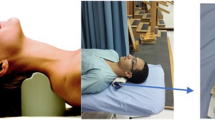Summary
Variability in amplitude and latency after median nerve, peroneal nerve and cauda equina stimulation has been evaluated in both healthy and diseased and manipulated and non-manipulated cords using the paired t-test. Three periods during operation were compared in individual cases. It could be demonstrated that amplitudes are more variable than latencies, that variability increases towards the end of the procedure and that variability is larger in diseased and manipulated cords than in healthy non-diseased cords. Cauda equina stimulation yielded relatively little variability in patients with manipulated spinal cords, similar to the variability after median nerve stimulation in healthy persons.
Access this chapter
Tax calculation will be finalised at checkout
Purchases are for personal use only
Preview
Unable to display preview. Download preview PDF.
Similar content being viewed by others
References
Brown RH, Nash CL (1985)Intraoperative somatosensorisch evozierte kortikale Potentiale bei spinalen Operationen — Rückenmarkmonitoring. In: Schramm J (Hrsg) Evozierte Potentiale in der Praxis. Springer, Berlin Heidelberg New York Tokyo, S 153–182
Gonzalez EG, Hajdu M, Keim H, Brand L (1984) Quantification of intraoperative somatosensory evoked potentials. Arch Phys Med Rehabil 65:721–725
Nordwall A, Axelgaard J, Harado Y, Valencia P, McNeil D, Brown J (1979) Spinal cord monitoring using evoked potentials recorded from vertebral bone in cat. Spine 4:486–494
Thurner F, Schramm J, Romstöck J, Fahlbusch R (1985) Effects of Fentanyl and Enflurane on cortical and subcortical SEP during general anesthesia in man. This volume, pp 82-89
Worth RM, Markand ON, De Rosa GP, Warren C (1982) Intraoperative somatosensory evoked response monitoring during spinal cord surgery. In: Courjon J, Mauguière F, Revol M (eds) Clinical applications of evoked potentials in neurology. Raven Press, New York, pp 367–373
Author information
Authors and Affiliations
Editor information
Editors and Affiliations
Rights and permissions
Copyright information
© 1985 Springer-Verlag Berlin Heidelberg
About this paper
Cite this paper
Schramm, J., Romstöck, J., Thurner, F., Fahlbusch, R. (1985). Variance of Latency and Amplitude in SEPs Monitored During Spinal Operations with and Without Cord Manipulation. In: Schramm, J., Jones, S.J. (eds) Spinal Cord Monitoring. Springer, Berlin, Heidelberg. https://doi.org/10.1007/978-3-642-70687-5_22
Download citation
DOI: https://doi.org/10.1007/978-3-642-70687-5_22
Publisher Name: Springer, Berlin, Heidelberg
Print ISBN: 978-3-642-70689-9
Online ISBN: 978-3-642-70687-5
eBook Packages: Springer Book Archive




